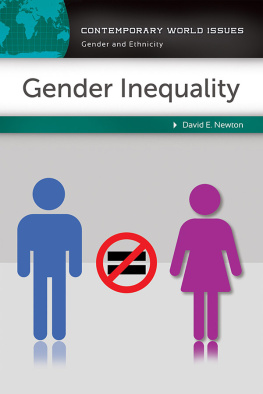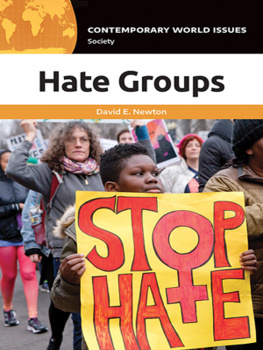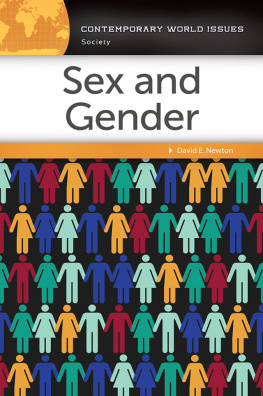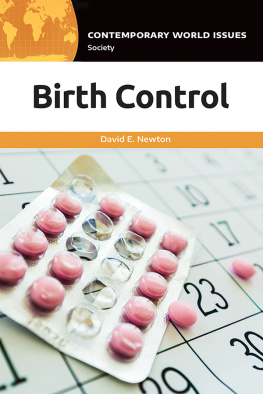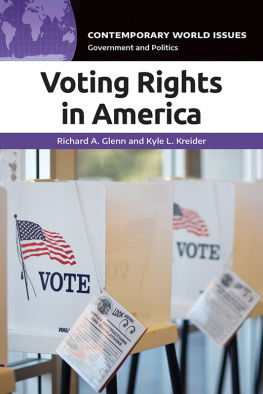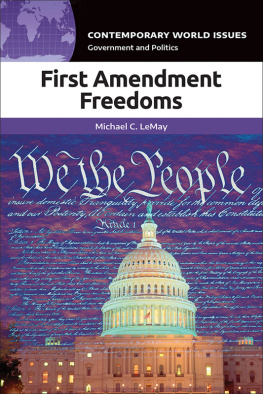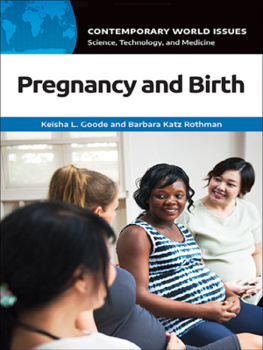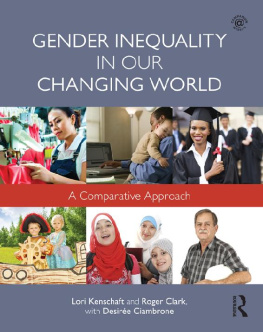Gender Inequality
Gender Inequality
Recent Titles in the
CONTEMPORARY WORLD ISSUES
Series
Women in Sports: A Reference Handbook
Maylon Hanold
Robots: A Reference Handbook
David E. Newton
Homeland Security: A Reference Handbook
Michael C. LeMay
The Opioid Crisis: A Reference Handbook
David E. Newton
Abortion in the United States: A Reference Handbook, second edition
Dorothy E. McBride and Jennifer L. Keys
The Youth Unemployment Crisis: A Reference Handbook
Christine G. Villegas
Transgender: A Reference Handbook
Aaron Devor and Ardel Haefele-Thomas
Eating Disorders in America: A Reference Handbook
David E. Newton
Natural Disasters: A Reference Handbook
David E. Newton
Immigration Reform: A Reference Handbook
Michael C. LeMay
Vegetarianism and Veganism: A Reference Handbook
David E. Newton
The American Congress: A Reference Handbook
Sara L. Hagedorn and Michael C. LeMay
Disability: A Reference Handbook
Michael Rembis
Books in the Contemporary World Issues series address vital issues in todays society such as genetic engineering, pollution, and biodiversity. Written by professional writers, scholars, and nonacademic experts, these books are authoritative, clearly written, up-to-date, and objective. They provide a good starting point for research by high school and college students, scholars, and general readers as well as by legislators, businesspeople, activists, and others.
Each book, carefully organized and easy to use, contains an overview of the subject, a detailed chronology, biographical sketches, facts and data and/or documents and other primary source material, a forum of authoritative perspective essays, annotated lists of print and nonprint resources, and an index.
Readers of books in the Contemporary World Issues series will find the information they need in order to have a better understanding of the social, political, environmental, and economic issues facing the world today.
CONTEMPORARY WORLD ISSUES
Gender Inequality
A REFERENCE HANDBOOK
David E. Newton

Copyright 2019 by ABC-CLIO, LLC
All rights reserved. No part of this publication may be reproduced, stored in a retrieval system, or transmitted, in any form or by any means, electronic, mechanical, photocopying, recording, or otherwise, except for the inclusion of brief quotations in a review, without prior permission in writing from the publisher.
Library of Congress Cataloging-in-Publication Data
Names: Newton, David E., author.
Title: Gender inequality : a reference handbook / David E. Newton.
Description: 1st Edition. | Santa Barbara : ABC-CLIO, 2019. | Series: Contemporary world issues | Includes bibliographical references and index.
Identifiers: LCCN 2019026770 (print) | LCCN 2019026771 (ebook) | ISBN 9781440872877 (ebook) | ISBN 9781440872860 (hardback)
Subjects: LCSH: Sex discrimination against women. | Sex role. | WomenSocial conditions. | Equality. | Feminist theory.
Classification: LCC HQ1237 (ebook) | LCC HQ1237 .N49 2019 (print) | DDC 305.42dc23
LC record available at https://lccn.loc.gov/2019026770
ISBN: 978-1-4408-7286-0 (print)
978-1-4408-7287-7 (ebook)
23 22 21 20 191 2 3 4 5
This book is also available as an eBook.
ABC-CLIO
An Imprint of ABC-CLIO, LLC
ABC-CLIO, LLC
147 Castilian Drive
Santa Barbara, California 93117
www.abc-clio.com
This book is printed on acid-free paper 
Manufactured in the United States of America
For Roxanne,
my good friend
Contents
by Sandy Becker
by Kathleen Frost
by Emily Hirsch
by Carolyn Hoemann
by Lila Leatherman
by Maeve McCarthy, Stephen Cobb, Claire Fuller, Paula Waddill, and Robin Zhang
by Alyssa Kara Miller
by Kimberly A. Probolus
by Jay Sorensen
by Marissa Williams and Martha Rampton
In elections held in November 2018, 93 new members were elected to the U.S. House of Representatives and 9 new members to the U.S. Senate. Of that number, 31 new House members (33%) and 3 new senators (33%) were women. That brought the total number of women in the House and Senate to 102 out of 435 (23%) and 24 out of 100 (24%), respectively. At the same time, 12 out of 36 (33%) newly elected governors were women. During the time the 2018 election was taking place, women made up 50.8 percent of the population of the United States. One might say that there is a condition of gender inequality in U.S. politics. That is, the fraction of women involved in national politics is not equal to (or even close to) the overall fraction of women in the nation.
Gender inequality is by no means strictly a political phenomenon. In almost every section of society, women do less well by a variety of measures than do men. For example, the average salary for women playing in the Womens National Basketball Association in 2018 was $71,635. By comparison, the minimum salary for a player in the mens version of the game (without his having played in a game) is $838,464 and (with one year of experience), $1,349,383. In yet another field, Nobel Prize awards throughout history, men have strongly predominated. Of the 180 prizes in chemistry given over the 117 years of its existence, 5 have gone to women (2.7%). For the other prizes, a similar trend exists: physics: 3 women among 210 winners (1.4%); physiology or medicine: 12 women among 216 winners (5.6%); and economics: 1 woman among 80 recipients (1.2%).
Or one can choose a very different measure of gender inequality: What is the average pay for men and women doing essentially the same job? In 1960, that pay gap was 0.61. That is, women received 61 cents for every $1 earned by a man doing the same job. Over time, that gap has improved slowly in the United States, reaching 81 cents to $1 in 2017. (In some countries that pay gap is much larger, almost 30 percent in Estonia and 25 percent in Japan.)
Neither women nor men need to be made aware of gender inequality in this country, or almost anywhere else in the world. The problem is not a new one, having been around throughout essentially all of civilization. One can find references to differential treatment of men and women in the earliest written records of laws and court cases. By the Middle Ages, denigrating comments about the abilities, morality, accomplishments, and limitations of women had become part of the scholarly tradition. At the time, many of these comments came from the writings of the most venerated saints and other church leaders, whose ideas were also being carried out in the structure and function of all Western religions at the time. of this book summarizes this long history of discrimination against women throughout history.
A comparable discrimination against men is a more difficult story to tell. There certainly have been times and situations when women exerted privileges unavailable to men in similar situations. But those instances have been few and far between, and their history would constitute a much shorter chapter than the one found here.

